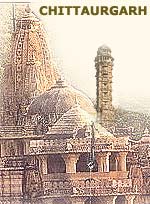 The hilltop fortress of Chittaurgarh epitomizes the whole romantic, doomed ideal of Rajput chivalry. Three times in its long history, Chittor was sacked by a stronger enemy and, on each occasion, the end carne in textbook Rajput fashion as jauhar was declared in the face of impossible odds. The men donned the saffron robes of martyrdom and rode out from the fort to certain death, while the women and children immolated themselves on a huge funeral pyre. Honour was always more important than death.
The hilltop fortress of Chittaurgarh epitomizes the whole romantic, doomed ideal of Rajput chivalry. Three times in its long history, Chittor was sacked by a stronger enemy and, on each occasion, the end carne in textbook Rajput fashion as jauhar was declared in the face of impossible odds. The men donned the saffron robes of martyrdom and rode out from the fort to certain death, while the women and children immolated themselves on a huge funeral pyre. Honour was always more important than death.
Despite the fort’s impressive locations and colourful history, Chittor is well and truly off the main tourist circuit and sees surprisingly few visitors. It’s well worth the detour.
History
Chittor’s first defeat occurred in 1303 when Ala-ud-din Khilji, the Pathan King of Delhi, besieged the fort in order to capture the beautiful Padmini, wife of the Rana’s uncle, Bhim Singh. When defeat was inevitable the Rajput noblewomen, including Padmini, committed sati and Bhim Singh led the orange-clad nobleman out to their deaths.
The final sack of Chittor came just 33 years later, in 1568, when the Mughal emperor, Akbar, took the town. Once again, the fort was defended heroically but, once again, the odds were overwhelming and the women performed sati, the fort gates were flung open and 8000 orange-robbed warriors rode out to their deaths. On this occasion, Maharana Udai Singh fled to Udaipur where he re-established his capital. In 1616, Jehangir returned Chittor to the Rajputs but there was no attempt at resettlement.
Orientation
The fort stands on a 280-hectare site on top of a 180-metre-high hill, which rises abruptly from the surrounding plain. Until 1568, the town of Chittor was also on the hilltop within the fort walls but today’s modern town, known as Lower Town, sprawls to the west of the hill. A river separates it from the bus stand, railway line and the rest of the town.
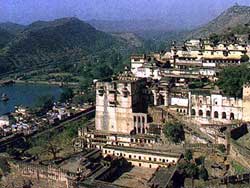 Fort
Fort
Bhim, one of the Pandava heroes of the Mahabharata, is credited with the fort’s original construction. All of Chittor’s attractions are within the fort. A zigzag ascent of over one km leads through seven gateways to the main gate on the western side, the Ram Pol.
On the climb, you pass two chhatris, memorials marking spots where Jaimal and Kalla, heroes of the 1568 siege, fell during the struggle against Akbar. Another chhatri, further up the hill, marks the spot where Patta fell. The main gate on the eastern side of the fort is the Suraj Pol. Within the fort, a circular road runs around the ruins and there’s a deer park at the southern end.
Today, the fort of Chittor is a virtually deserted ruin, but impressive reminders of its grandeur still stand. The main sites can all be seen in half a day (assuming you’re not walking) but, if you like the atmosphere of ancient sites, then it’s worth spending longer as this is a very mellow place and there are no hassles whatsoever.
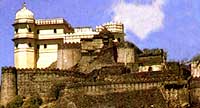 Rana Kumbha Palace
Rana Kumbha Palace
Entering the fort and turning right, you come almost immediately to the ruins of this palace. It contains elephant and horse stables and a Siva temple. One of the jauhars is said to have taken place in a vaulted cellar. Across from the palace is the archaeological office and museum, and the treasury building or Nau Lakha Bhandar.
Fateh Prakash Palace
Just beyond the Rana Kumbha Palace, this palace is much more modern (Maharana Fateh Singh died in 1930). It houses a small and poorly lit museum, and the rest of the building is closed. The museum is open daily except Friday from 10 am to 4pm.
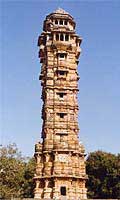 Tower of Victory
Tower of Victory
Continuing anticlockwise around the fort, you come to the Jaya Stambh, or Tower of Victory. Erected by Rana Kumbha to commemorate his victory over Mahmud Khilji of Malwa in 1440, the tower was constructed between 1458 and 1488. It rises 37 metres in nine storeys and you can climb the narrow stairs to the top.
Hindu sculptures adorn the outside of the tower, but the dome was damaged by lightning and repaired during the last century. Close to the tower is the Mahasati, an area where the ranas were cremated during Chittorgarh’s period as the Mewar capital. There are many sati stones here. The Sammidheshwar Temple stands in the same area.
Tower of Fame
Chittor’s other famous tower, the Kirti Stambha, or Tower of Fame, is older (probably built around the 12th century) and smaller (22 metres high) than the Tower of Victory. Built by a Jain merchant, it is dedicated to Adinath, first Jain tirthankar, and is decorated with naked figures of the various tirthankars, thus indicating that it is a Digambara, or ‘sky clad’, monument. A narrow stairway leads through the seven storeys to the top.
Padmini Palace
Continuing south, you come to Padmini’s Palace, built beside a large pool with a pavilion in its centre. Legends relate that, as Padmini stood in this pavilion, Ala-ud-din was permitted to see her reflection in a mirror in the palace. This glimpse was the spark the convinced him to destroy Chittor in order to possess her.
The bronze gates in this pavilion were carried off by Akbar and can now be seen in the fort at Agra. Continuing round the circular road, you pass the deer park, the Bhimlat Tank, the Suraj Pol gate and the Neelkanth Mahadev Jain temple, before reaching the Tower of Fame.
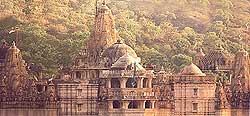 Gaumukh
Gaumukh
Walk down beyond the temple and, at the very edge of the cliff, you’ll see this deep tank. A spring feeds the tank from a carved cow’s mouth in the Cliffside- from which the reservoir got its name. The opening here leads to the cave in which Padmini and her compatriots are said to have committed jauhar.
Other Buildings
Close to the Fateh Prakash Palace is the Meera Temple, built during the reign of Rana Kumbha in the ornate Indo-Aryan style and associated with the mystic-poetess Meerabai. The larger temple in this same compound is the Kumbha Shyam Temple, or Temple of Virji. The Jain (but Hindu influenced) Singa Chowri Temple is nearby.
Across from Padmini’s Palace is the Kalika Mata Temple, an 8th –century Surya temple. It was later converted to a temple to the goddess Kali. At the northern tip of the fort is another gate, the Lokhota Bari, while at the southern end is a small opening from which criminals and traitors were hurled into the abyss.